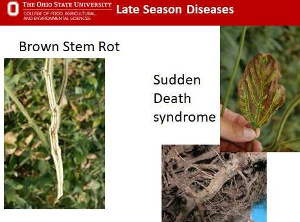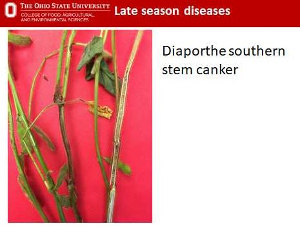3. Late season Phytophthora stem rot. On varieties that have low levels of field tolerance or partial resistance, stem rot is popping up in fields that have received some of these heavy down pours over the last few weeks. Make notes of these varieties and remove them from the line up for next year.

4. There are reports of some soybean plants with early symptoms of Sudden death syndrome. Several of these late season diseases can have similar symptoms so the first step is to check the pith. If it is white that fits with sudden death syndrome. If it is brown-chocolate brown it is brown stem rot and if it is a reddish brown then it is Diaporthe (southern). Also look at the roots, the fungus that causes sudden death syndrome is also a very good root rotter, but the fungi that cause brown stem rot and Diaporthe are wimps in this category.

The best means to manage all of these diseases is first with variety selection. As the sales have started for the 2019 season, take a look at those ratings first and for any other issue that you are finding affecting soybeans this year. It’s a great year to weed out the wimps.
Source: osu.edu